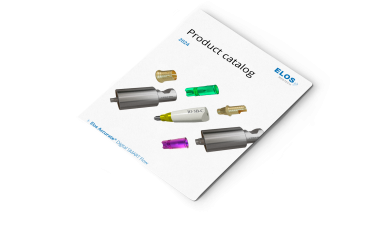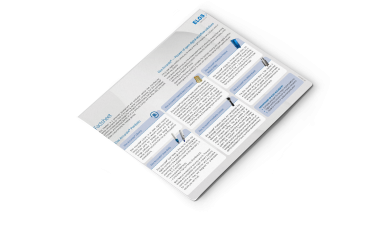Derived from a true family business, Team Oxby diagnose and treat patients in their dental clinic and in-house lab in Sweden. With a great interest in implantology, Dentist Fredrik Oxby renovates old Cresco Bridges using Elos Accurate as part of his job. I spoke to him about the digital workflow, the challenges of digital dentistry and what he would like to see in the future.
Hi, Fredrik! Digitalization is snowballing its way into the dental industry. How do you as a dentist notice the change?
In general, dental technicians seem to be steps ahead compared to dentists. In my opinion, it is the technicians who drive the entire digital dentistry forward. Lab scans and other digital equipment have been around for some time. I think it is very unlikely for the technicians to step away from the digital workflow at this point.
Dentists, on the other hand, are not quite there yet. The reports on digital dentistry have been somewhat contradictory in dentist circles. There are of course many dentists who use digital equipment such as intraoral scanners. But I think the majority still work the traditional way. At the same time, digital dentistry is growing stronger each year. As a dentist, you cannot deny that there is a threshold that needs to be crossed.
Interesting. Do you recognize any challenges of digital dentistry?
In my opinion, the greatest challenge of digital dentistry is the initial investment. Starting fresh as a dentist, you may not immediately think of investing in the digital technology, but first and foremost dental chairs and other essential equipment. If deciding on investing in the digital technology, there is also the aspect of getting a return of your investment. However, for me, personally, it feels unreasonable to go back to a traditional workflow after years of working digitally.
Then there is also the challenge of learning how to handle the digital equipment you invest in. Taking a digital impression is very easy once you get the hang of it. But as with anything else, practice makes perfect. Regardless of technique – may it be digital or conventional – it is always crucial to continuously analyze your workflow and how you use the equipment to make sure you get accurate results each time.
You use an intra-oral scanner on a daily basis. What are the benefits?
Where to begin? First of all, using an intraoral scanner allows for great predictability and accurate results. In my opinion, it is much easier compared to the conventional method. You avoid the messiness and eliminate the time-consuming process of having to do the procedure all over again if not getting it right the first time. With an intra-oral scanner, you can add information straight away to perfect the impression; as many times as you need and in a matter of seconds.
As for the patients, using an intraoral scanner reduces the discomfort of having rubber-like foul-tasting material in your mouth. It minimizes treatment time and provides the patients with immediate feedback via the computer screen. I think, in a way, digital dentistry is also a measure of how much you invest in your patients.
For the dental technician, a lot of steps in the work process are eliminated with digital dentistry. As a matter of fact, when our dental technician creates single crowns, for example, he never creates a model. The digital impression is the model and he already knows the crown will fit perfectly. This is pretty fascinating: I take a digital impression of the patient’s teeth. Later, the patient has a crown installed that never existed in reality. It has been created digitally and then printed – and fits perfectly in the patient’s mouth.
That is fascinating! Tell me more about the digital equipment you use?
We use an intraoral scanner for about 90 percent of all of our prosthetic cases including Elos Accurate Scanbody. The remaining ten percent are more complicated cases such as full implant-supported bridges and removable dentures. Our digital workflow includes close collaboration with our dental technician. This provides great advantages in terms of communication and time-efficiency. Working with digital impressions means that our technician is able to catch any issues and provide us with necessary feedback to achieve successful restorations in less time.
You renovate old Cresco bridges using a digital workflow and Elos Accurate components. Describe your part of the process?
My part of the process is pretty straightforward. When a patient comes in with a, let us say, fifteen years old Cresco bridge, I detach the bridge from the patient’s mouth and clean it. I then hand it over to our dental technician who starts the renovation process.
A model is made to determine the position of the implants to the new bridge. The old bridge is copied with the lab scanner and turned into a digital file. Additional design work is made in the digital software if necessary. The new bridge is then milled in-house in a ceramic material, which is more sustainable than the previously used acrylic material. Our dental technician returns the renovated bridge to me and I install it in the patient’s mouth.
We use Elos Accurate Hybrid Base Bridge for the cementation process together with the dental components from the corresponding Elos Accurate Libraries.
What is your experience of change in the dental industry?
Traditionally, we have seen dental companies offering excellent solutions but with closed systems and workflows. This is a trend that has gone in cycles but, luckily, the industry is finally starting to move away from it. 3Shape and Elos Accurate are great examples of that.
I believe in using open systems that involve both dentists and technicians, allowing them to make their own choices. This is also a way of driving development forward in the dental industry. It is also an important aspect from the patients’ point of view. Traditionally, the dentists have had a huge advantage over patients in terms of knowledge. As a dentist, your work has a direct impact on another person’s body. With open systems, however, it is much easier to involve the patients in the process, providing more options to choose from such as materials and components.
What digital dentistry solutions would you like to see in the future?
Being able to renovate old Cresco bridges is fantastic, but we sometimes struggle with getting hold of the right spare parts. An older patient may have one implant from 1988 and another from 1995. In addition, we are installing a new implant from 2018. It is not always easy to find the correct components. Elos Medtech is doing a good job of providing the screws needed, but I think in the future, this will become an even greater challenge.
Another solution I would like to see in the future is a digital version of the Cresco Index. The Cresco Index was developed years ago by my father, Gert Oxby. It is screwed on to the dental implant and when taking the impression, the patient bites the jaws together and this will give you the correct height. The Cresco Index was actually initially meant to be a digital solution. However, Gert was ahead of his time as digital dentistry had not yet made its entrance into the dental industry. But this is something I very much hope to see in the future!
Thank you so much, Fredrik, for sharing your knowledge and experiences. It was lovely chatting to you.
For more information about Elos Accurate, please visit Elos Dental. If you are more curious about Team Oxby, you can learn more on their website.



